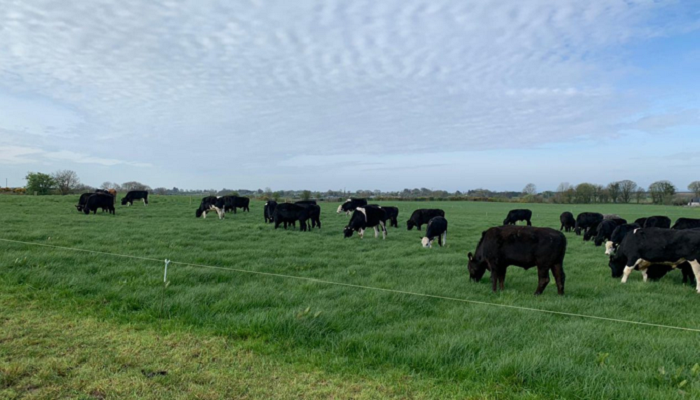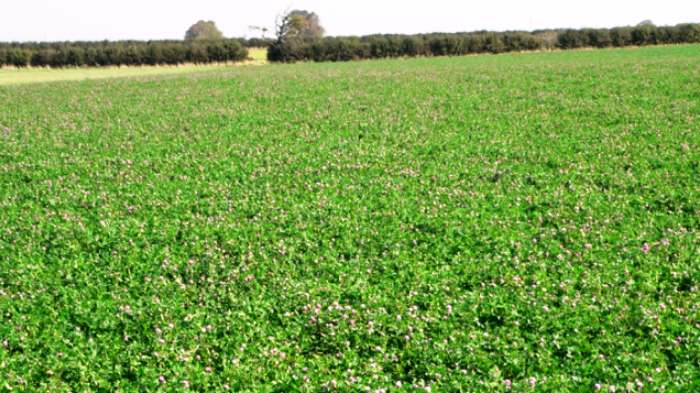27 March 2023
Breathing new life into a calf-to-beef system in Co. Meath

Aidan Maguire, who farms 46ha of free-draining grassland in partnership with his son Luke, just outside Navan, Co. Meath, has reinvigorated his farm since 2018.
Having previously operated a system where dairy-beef animals were sold as stores weighing 450kg at 24 months, with only the worst performers – those not fit for showing in the sale ring – finished, Aidan has moved to a system where all animals are now carried to beef.
Aidan, one of the keynote speakers at the recent DairyBeef 500 Spring Conference in Navan, Co. Meath, explained how a focus on animal performance and grassland management – influenced by his participation in the Teagasc Green Acres Programme (the predecessor to the DairyBeef 500 Campaign) and a local Grass 10 discussion group – has resulted in a swing in profitability of €1,350/ha between 2018 and 2022.
He explained: “I got the opportunity to join the Teagasc Green Acres Programme in 2019 to learn how things could be done better. In the beginning we focused on sourcing calves from local farmers with good set ups and high attention to detail when it comes to calves. This has been the real game changer for calf health.”

Previous to changing the sourcing strategy, Aidan bought calves from farmers, marts and dealers, a venture which he described as a “recipe for disaster”, adding: “I think at some stage I had lost calves from every ailment that was out there.” Along with changing the sourcing model, a vaccination programme for pneumonia and IBR was also introduced, which has resulted in the farm’s level of calf mortality being 0% over the past two years.
On calf rearing, Aidan said: “We now buy approximately 140 calves between autumn and spring, 25% in the autumn and 75% in the spring. Included in that there could be 20-30 heifers and they are all from three or four local farms.
“The calves must be at least three weeks old. Any animal that doesn’t look 100% is left behind. I only rejected two calves this year and took them the following week because they were both up to scratch. All spring calves must be born in January or February. Later calves cause a lot of extra feeding in the first and second year.”
Describing the protocol for when calves arrive on his farm, Aidan said: “They get a coccidiosis dose before they leave the trailer and two days later they get their pneumonia and IBR vaccinations. I use plenty of straw in the pens, up to a foot deep in each pen. If you can still feel the concrete under your welly, they need more straw.
“There has been a very noticeable drop in health issues; I nearly only ever see the vet at TB testing. However, I do like him to call and check on anything that looks a bit below par and to get his opinion,” Aidan explained.
Another key action Aidan undertook was to monitor the performance of his animals at various stages throughout the cycle.
“Targets were set for weaning weights and meal intake and this saved a lot of over feeding of milk replacer. We now feed 17kg of milk replacer per calf and calves are weaned once they are eating at least 2kg of ration per day, when calves are 8-9 weeks of age weighing 80-90kg,” he said.
“Looking back at the figures, the change has been huge. In 2018, I had a net margin of -€83/ha before subsidies. My net margin in 2022 was €1,267/ha and I put that down to having targets and trying to achieve them – weaning weights, yearling weights and carcass weights. After that, I think it’s about feeding cattle as cheaply as possible and that’s grass.”
Grassland management
Aidan has been working closely with John Douglas of Teagasc’s Grass 10 Campaign for the last number of years, citing the participation in a Grass 10 discussion group as one of the key elements in improving farm profitability.
“I measure grass weekly and we started discussing the figures and what they tell us about our grass situation. I really got into it and the benefits of knowing what grass was available and having the right covers to produce the best thrive at each stage of management for the cattle.”
Achieving “cheap” weight gain from grass in both the early spring and into the late autumn are key components of Aidan’s grass-based system. This is aided by an excellent paddock system and pathways – for easy access to the paddocks – on the farm.
“I had a paddock system on the farm for at least 20 years – 16 or 17 5ac paddocks. In 2021, I redesigned the layout and created 36 paddocks of 1ha approximately. It was like getting more land. At any given time, I have 30 different paddocks to choose from to select the right grass for cattle,” Aidan noted.
Another key grassland focus area has been producing the best quality silage as possible to limit the quantity of expensive concentrates required to achieve the targeted levels of weight gain of 0.6kg/head/day for weanlings and +1kg/head/day for finishing stock over the winter months. A red clover / perennial ryegrass sward has been introduced on the farm to reduce artificial nitrogen inputs when producing winter feed; white clover is continually being added to grazing swards – both through reseeding and stitching. Aidan’s proficiency as a grassland manager cannot be underestimated and he was awarded the Drystock Grassland Farmer of the Year in 2021 for the improvements and the levels of production he’s achieving.

Breeds
Aidan purchases a number of breeds each year, with the majority being Holstein Friesian males. The heifers are generally Hereford, Angus and Belgian Blues. These are slaughtered at 19-20 months at a target carcass weight of 255kg and are marketed before housing in the second winter. A number of steers, which are of adequate liveweight are also slaughtered before housing, provided ground conditions and grass supplies permit finishing outdoors. All animals on the farm were slaughtered before 24 months of age this year, regardless of breed type.
On why the majority of animals are dairy-bred males, Aidan commented: “The reason I like the Friesian bull calf is firstly price and secondly I’m fairly sure I’m going to get 300kg of carcass, grading P+ to O= before 24 months. Friesians are good at turning grass into meat; grass is my best asset on the farm.
“The beef breeds are three to four times more expensive and many times it’s very hard for them to make €150-200 more than the Friesian at slaughter. I blame that on the short-gestation, easy-calving bulls available, with very low figures for beef characteristics. There is huge room for improvement there, maybe if a dairy farmer could spend 15 minutes and €15 more selecting better bull straws, than I could give €100 more for those calves.”
He continued: “I’d love to buy calves of higher beef genetics at realistic prices – a decent calf at a decent price. I know what I am getting when I buy a Friesian and they work well for me. Other breeds are not so consistent and the purchase price doesn’t reflect their true or real potential.”
Profitability
The central focus on calf sourcing, achieving target weights and utilising grass as efficiently as possible has delivered for Aidan. As mentioned, the farm generated at net loss of €83/ha in 2018 before subsidies, meaning that non-production related payments were used to cover the overheads incurred by producing beef.
Table 1: Profitability changes on Aidan Maguire’s farm
| 2018 | 2019 | 2020 | 2021 | 2022 | |
|---|---|---|---|---|---|
| Gross output (kg/ha) | 982 | 858 | 1,496 | 1,555 | 1,671 |
| Gross output (€/ha) | 1,493 | 1,588 | 2,807 | 2,876 | 4,358 |
| Variable costs (€/ha) | 951 | 894 | 1,205 | 1,404 | 2,127 |
| Gross margin (€/ha) | 542 | 694 | 1,603 | 1,472 | 2,231 |
| Fixed costs (€/ha) | 625 | 651 | 641 | 722 | 981 |
| Net margin excl. subsidies (€/ha) | -83 | 43 | 1,032 | 758 | 1,267 |
Since then, however, net margin has improved to €1,267/ha – a swing of €1,350/ha in just four years. This has been achieved largely by stocking the farm appropriately to utilise the cheapest feedstuff Aidan has available, which is reflected in his gross output (cattle sales minus cattle purchases and add/subtract any changes to the inventory), which has climbed from 982kg/ha in 2018 to 1,671kg/ha in 2022. In monetary terms, that’s an improvement of €2,865/ha.
Although variable costs have more than doubled on the farm and fixed costs have risen by 57%, the levels of output being achieved are more than adequate to generate a very respectable profit from beef production. Going forward, Aidan will strive to reduce his costs of production, a journey which has already commenced through the introduction of both red and white clover cultivars in his silage and grazing swards to reduce the need for purchased chemical nitrogen.
For more information on the DairyBeef 500 Campaign, click here.
